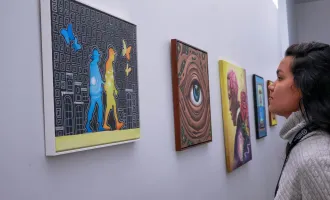
The Dark Side of Gold
The San Francisco Opera recently added their voice to the many speaking out against the prejudice and bigotry rife within our country. December 2017 saw the close of a newly released Opera, titled “Girls of the Golden West,” where composer John Adams and director Peter Sellers take us through vignettes of the 1850s California gold rush.
The timing of this Opera and overt parallels between past and present send a clear message: despite a gap of over 150 years, America is just as divided today by racial, cultural, and gender discrimination as was prominently featured during California’s founding.
The story unfolds from the perspective of three strong women of differing ethnicities as they struggle against racial and sexual belittlement.
The first half of the opera depicts the desperate dreams of those who believed money equates happiness. A mob of white American men belt their intention to get rich quick, whilst gambling and drooling over prostitutes.
"You dream of gold, as though you were a poet
You lose yourself, even though you know it”
-Ramón, Girls of the Golden West
And lose themselves they did. The second act contrasts the dreams of lavish living with the harsh reality of poor living conditions and racial discrimination.
Golden Californian promises attracted people from diverse regions, ethnicities and cultural backgrounds. Fugitive African-American slaves, Chilean, Mexican, and Chinese immigrants, and white Americans were among the sudden influx of 300,000 people.
In the Opera, Chileans are shot for not having the money to pay absurdly high taxes. Mexicans are whipped violently in the streets. African-Americans are hung or run off from the gold mines for speaking out against oppression.
Most of the libretto, or the text accompanying the music, is taken directly from diaries, letters, and poems from oppressed groups written in the 1850s. Frederick Douglass’ speech “What to the Slave is the Fourth of July?” was also adapted into an operatic solo.
There is one particularly striking scene: the mob of angry, white men lounges in front of a singing Asian prostitute, red solo cups full of beer casually in hand. After she sings a wonderful piece, captivating the men only in that brief moment, the woman is taunted and physically harassed as the men yell “Get out yellow-skins, get out!”
The contrast of modern red plastic, symbolizing the classic American college party, with the rustic costumes of the 1850s made clear Adams’ commentary on the symmetry between past and present.
Quoted in an article from The New York Times, Adams got inspiration for the many white mob scenes from Trump rallies during the past election.
On opening night, he stated in his closing address to the audience that there could be no better time for the release of this piece. It forces us to engage with our rich history and reflect on where we stand today as a nation.
This opera is not only controversial in the intentional parallels to modern America, but also in the structure of the music itself. Adams is known for modern, atypical musical styling – the almost discordant twinges of a guitar punctuate the orchestral music as a young Mexican woman cries for strength against her male oppressors.
The arts have always been a coveted place for political and social commentary. I admire not only the willingness of the SF Opera to put forth such a controversial piece, but also their facilitation of student access.
The SF Opera worked directly with me to provide heavily discounted tickets for 50 UCSF and Stanford graduate students to experience “Girls of the Golden West.”
This was the first opera for most of the students, who all agreed that the experience fell far outside expectation. The story forces us to stare hard into the ugly facets of our country. The stereotypic drama is poignant, not superfluous.
“The content was darkly self-aware,” said Kamir Hiam, a UCSF BMS graduate student.
The relevance of the piece to the present political climate and entirely English score make this opera more approachable for the inexperienced.
That’s not to say it was entirely interpretable, truthfully leaving many of these first-timers confused. Adam’s piece was akin to a piece of abstract art come alive on stage. His unique style left out traditional plot moving pieces of a story, opting for large metaphors and vignette examples of life in the California mines.
Alexis Krup, graduate student in the UCSF BMS program, said she’s grateful for the access to both science and art as a student in San Francisco.
“None of our pursuits - scientific, artistic, political etc... exist in a bubble, and I appreciate the perspectives we build when we participate in realms outside our main areas of study or work,” she said.
Students can reach out the to SF Opera ticketing department for student rate $35 tickets to any show, any available seat in the house!



